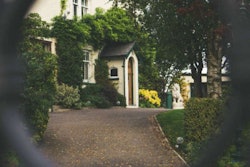 This custom bug box was built for Flora Grubb Gardens in San Francisco.
This custom bug box was built for Flora Grubb Gardens in San Francisco.Photo: Urban Hedgerow
For bird watchers there’s bird houses and now for insect lovers there are … bug hotels?
That’s right, as more people are becoming aware of the benefits of certain insects, they want to lend a helping hand. Pollinator gardens have been around for a while now, providing plenty of forage for bees and butterflies, but the creepy crawlies also need a place to rest.
Call them what you want – bug boxes, bug houses, or bug hotels – these abodes help encourage beneficial insects to visit and supplement the loss of their natural habitats.
Using these humble dwellings to attract bugs can also reduce a homeowner’s need for pesticides, as insects can naturally eliminate some of the garden pests.
Urban Hedgerow, based in San Francisco, California, is an example of a company that’s ahead of the curve with this trend. It currently creates beautiful bug boxes on commission. The devices are designed to attract different species of insects.
Built with cubbies, nooks and crannies, the spaces are filled with material like twigs, moss and bamboo to lure lady beetles, lacewings, spiders and the like.
Unlike honeybees, solitary bees seek out dry hollow tubes to lay their eggs, so bamboo poles and drilled logs provide adequate shelter for them. These bees are non-aggressive and do not swarm.
Because bugs aren’t that picky about where they live, these bug structures are easy to construct.
“Generally, they like dark crevices that are in a south-facing location so they can stay warm,” Lisa Lee Benjamin, founder of Urban Hedgerow, told SF Gate. “Small sticks, logs, hollow spaces like straws, bamboo and reeds, oat or wheat straw, mulch and bark also make good bedding material. They also require nearby plant matter and nectar sources for food, a little bit of water to drink and, depending on the species, anywhere from feet to thousands of miles to roam.”
Here are the basic steps to building a bug hotel:
- Frame: Create or find a structure to frame the hotel. This could be a wine crate, an old drawer, a shadow box, or any other shape that is 6 to 12 inches deep. It can either hang or be freestanding in the garden
- Compartments: Fill the interior with partitions that are secured to the frame. This can be anything from pipes welded together to cardboard paper towel rolls glued together.
- Site: Place the bug hotel in a south-facing spot near nectar sources. Keep the bug house 5 feet from the ground.
- Gather: Fill the compartments with dry material to attract the desired bugs. Material such as weeds, sticks, burlap, old paper and string are all suitable.
- Observe: Sit back and watch the bugs check in.









